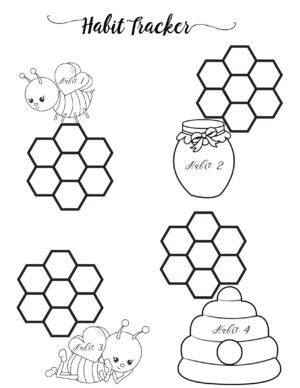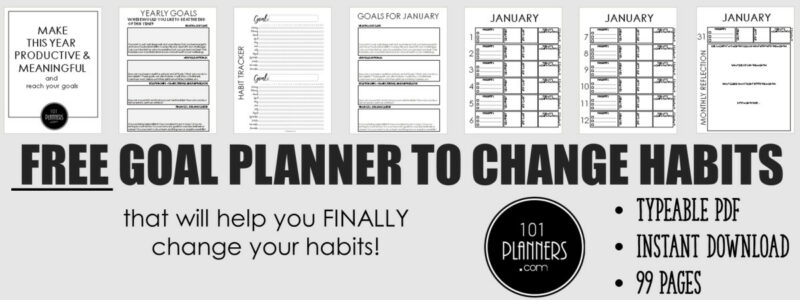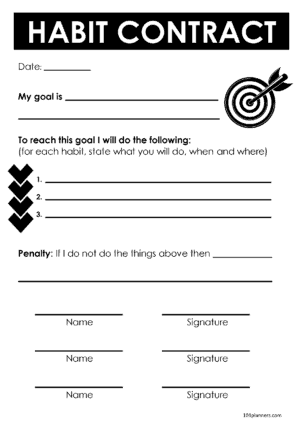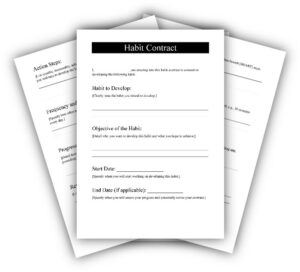Do you find it hard to change your habits? Our free habit tracker will provide an overview of your habit streaks. This will help you see how you are progressing and motivate you to continue the streak.
Printable Habit Tracker
![]()
Habit Tracker BuJo
![]()
We also offer a free goal planner to help you FINALLY change your habits.
Anything you learned, you can unlearn, too
Habits are not instantly created. They are things you have to do consistently for an extended period. According to James Clear, the author of the Atomic Habits, if you want to make a positive change in your life, you have to understand that change requires patience, as well as confidence that your habits are helping you progress in the right direction even if you don’t see immediate results. So if you find that your behaviors and habits don’t seem to be paying off, try to focus on your progress rather than your current results. This is where a habit tracker is really helpful. It shows you your progress in a visually appealing and fun way. James states that you don’t need to make major changes to your life all at once to have a big impact. Rather, make tiny changes to your behavior, which, when repeated over and over, will become habits that may lead to big results. Habits are acquired by learning and then by repetition. It is therefore essential that you repeat them regularly and consistently until a new habit is created.
Habit Tracker
with Other Sections
How to add a habit tracker to any planner on this site?
- Select any planner from any page on this site.
- Go to “Planner Inserts” and select “Habit trackers”.
- Select a habit tracker and click on it.
- Drag it to wherever you want it to appear. You can make it bigger or smaller and change the color as well.
Dedicated
Habit Tracker
![]()
Select any border/background
Weekly Habit Tracker
You can add a habit tracker to any weekly planner on this site. Open the planner maker and go to “Planner Inserts”. Select “Habit Trackers” and select any widget to add to the planner.

Monthly Habit Tracker
Mark each day you successfully complete the daily habit and you will see your progress.
There are three options for each of the following monthly planner inserts for 31, 30, or 28 days.
Start from any day of the month and complete the circle. Choose the version with 30 or 31 depending on the number of days that month.
Long-Term Tracker
Since studies show that it takes at least 66 days to change a habit these long-term trackers will have you covered!
You shouldn’t be challenging yourself to change a habit for just a short period of time. The point of habits is to change behavior over the long term.
Richard D. Rawlings (End Bad Habits)
Year at a Glance
Track a habit over a one-year period. There are many more yearly blank calendar designs and layouts.
I personally use this habit tracker. I love that I can see an entire year at a glance. I find that it keeps me accountable and helps me see my progress over time.
Habit Tracker Planner
This is a yearly goal planner with a habit tracker for each day and for an entire year at a glance. Changing your habits requires setting goals and making changes to achieve those goals. This goal planner will help you go through each of the stages to ensure you finally change your habits. The planner includes one full year and you can start it any month. You can also print one month only if you only want to use it for a month.

Keystone Habits
Not all habits are equal. Some habits are more important than others, since adhering to them spills over into other areas. These are called keystone habits. Keystone habits are “small changes or habits that people introduce into their routines that unintentionally carry over into other aspects of their lives” (The Power of Habit by Charles Duhigg). For example, when you exercise regularly then you are less likely to eat junk food. Research indicates that when obese patients focused on keeping a meticulous food journal, then other good habits started to take root as well. These habits should be doable and should cause some positive change in your life.
To cause a significant change focus on keystone habits
151 Habit Tracker Ideas
Here are some ideas for habits to track.
Health | Financial | Personal Development | Self-Care | Organization | Relationships
Health
- Increase Water Intake (see water tracker): Track and aim to increase your daily water consumption for improved hydration.
- Stop Drinking Soda: Eliminate soda from your beverage choices to reduce sugar and artificial ingredient intake.
- Limit Coffee Intake: Moderate your coffee consumption to avoid excessive caffeine and potential negative effects.
- Limit Alcohol Intake: Consume alcohol in moderation and set limits to promote overall health and well-being.
- Sleep more: Prioritize getting sufficient sleep to support optimal physical and mental functioning (see sleep tracker).
- Exercise 30 Minutes Daily: Engage in at least 30 minutes of physical activity each day for improved fitness and overall health.
- 10,000 Steps a Day: Strive to reach a daily step goal of 10,000 steps for increased movement and cardiovascular health.
- Eat More Vegetables: Incorporate a variety of vegetables into your meals to enhance nutrition and overall diet quality.
- Eat 5 a Day (Fruit and Veg): Aim to consume a minimum of five servings of fruits and vegetables daily for essential nutrients and antioxidants.
- Eat Clean: Opt for whole, unprocessed foods and minimize consumption of processed or packaged products.
- Floss Daily: Develop a habit of daily flossing to maintain oral health and prevent gum diseases.
- No Sugar: Reduce or eliminate added sugars from your diet for improved overall health and to manage blood sugar levels.
- Record period: Keep track of your menstrual cycle to monitor patterns and maintain reproductive health (see period tracker).
- Eat Breakfast: Make it a habit to eat a balanced breakfast to kickstart your day with essential nutrients and sustained energy.
- Spend 10 Minutes Outside (for Natural Light): Take a short break outdoors each day to benefit from natural light exposure.
- Meal plan: Plan and prepare meals in advance to support healthy eating habits and save time and money (see meal plan).
- No Smoking: Quit smoking or avoid starting smoking to safeguard your health and reduce the risk of associated diseases.
- Take Medication: Follow prescribed medication regimens as directed by healthcare professionals for proper management of health conditions (see medication log).
Financial
- Limit spending: Set a budget and consciously control your spending to stay within your financial means (see 30 day no spend challenge).
- Increase savings: Prioritize saving money by allocating a portion of your income towards savings regularly (see savings tracker).
- Cook More and Eat Out/Order In Less: Prepare meals at home more often to save money and make healthier food choices.
- Budgeting: Create and stick to a budget (see budget sheet template).
- Tracking Expenses: Monitor and categorize your spending (see expense tracker).
- Goal Setting: Establish short-term and long-term financial goals (see goal tracker).
- Debt Management: Develop a plan to pay off debt and avoid unnecessary debt.
- Mindful Spending: Differentiate between needs and wants when spending.
- Emergency Fund: Build and maintain an emergency fund.
- Regular Review: Periodically assess your finances and progress towards goals.
- Financial Education: Learn about personal finance and money management.
- Retirement Planning: Plan and save for retirement.
- Investment Strategy: Develop an investment plan aligned with goals and risk tolerance.
- Comparison Shopping: Compare prices and options before buying.
- Negotiating: Negotiate prices, fees, and interest rates.
- Avoiding Impulse Buys: Practice delayed gratification and avoid impulsive purchases.
- Using Coupons and Discounts: Utilize coupons, discounts, and loyalty programs.
- Prioritizing Insurance: Ensure adequate insurance coverage.
- Regular Bill Payment: Pay bills on time to avoid penalties.
- Reviewing Financial Statements: Check statements for accuracy and fraud.
Personal Development
- Track Mood (see mood tracker): Monitor and record your mood regularly to gain insights and track emotional well-being.
- Limit Screen Time: Set boundaries and reduce the amount of time spent on electronic devices.
- Limit Social Media: Control and reduce social media usage to prioritize real-life connections and well-being.
- Positive Affirmations: Practice self-affirmation by repeating positive statements to boost self-confidence and self-worth (see how to write affirmations).
- Gratitude log: Keep a gratitude log to regularly jot down things you are grateful for and foster a positive mindset.
- Visualize goals: Use visualization techniques to imagine and manifest your desired goals and aspirations (see goal chart).
- Journal Every Day: Make it a habit to write in a journal daily, expressing thoughts, emotions, and reflections (see journal template).
- Self-Reflection: Engage in introspection to gain self-awareness, learn from experiences, and foster personal growth.
- Creative Activity: Engage in a creative pursuit such as painting, drawing, or crafting to stimulate imagination and self-expression.
- Start a New Hobby: Explore and initiate a new hobby or interest to learn and cultivate new skills.
- Enjoy a Hobby: Dedicate regular time to indulge in a hobby you already love to relax and unwind.
- Practice an Instrument: Regularly practice playing a musical instrument to enhance skills and enjoy the therapeutic benefits.
- Read a book: Set aside time to read books that interest you to expand your knowledge and immerse in different worlds (see reading log).
- Volunteer: Contribute to your community by engaging in volunteer work to make a positive impact and gain fulfillment.
- Lifelong Learning: Dedicate time each week to learn something new or deepen your knowledge in a specific area.
- Goal Setting: Set specific and measurable goals for various areas of your life and review them regularly.
- Daily Reflection: Allocate time each day for self-reflection to assess your actions, experiences, and personal growth.
- Effective Time Management: Develop a structured approach to managing your time, prioritizing tasks, and avoiding procrastination.
- Reading: Incorporate a habit of reading regularly, whether it’s books, articles, or other educational materials.
- Networking: Set aside time for networking activities, such as attending industry events or reaching out to professionals in your field.
- Personal Growth Journaling: Maintain a journal dedicated to personal growth, capturing reflections, insights, and progress (see journal templates).
- Mindfulness Practice: Incorporate daily mindfulness practice, such as meditation or mindful breathing, to enhance self-awareness and focus.
- Skill Development: Dedicate regular time to practice and improve key skills relevant to your personal and professional growth.
- Emotional Intelligence: Cultivate emotional intelligence by practicing self-awareness, self-regulation, empathy, and effective interpersonal communication.
- Mentorship: Seek out mentors and establish regular meetings or interactions to gain guidance and support in your personal and professional development.
- Reflecting on Failures: Embrace failure as an opportunity for growth, regularly reflect on lessons learned, and apply those insights to future endeavors.
- Attending Workshops and Seminars: Actively seek out and participate in workshops, seminars, or conferences to expand your knowledge and skills.
- Personal Development Reading: Set aside dedicated time each week to read personal development books, articles, or other educational resources.
- Cultivating Positivity: Practice gratitude, positive affirmations, and solution-oriented thinking to foster a positive mindset.
Self-Care
- Meditate: Dedicate time to practice meditation for relaxation and mindfulness.
- Deep Breathing: Incorporate deep breathing exercises to reduce stress and promote relaxation.
- Yoga: Engage in regular yoga sessions to improve flexibility, strength, and mental clarity.
- Stretch: Take breaks throughout the day to stretch your body, relieve tension, and increase blood flow.
- Haircare: Take care of your hair by following a regular hair care routine.
- Skincare: Prioritize skincare by establishing a skincare regimen that suits your skin type.
- Remove Makeup: Make it a habit to thoroughly remove makeup before bed to keep your skin clean.
- Moisturize: Hydrate your skin by applying moisturizer regularly to keep it soft and nourished.
- Relax: Incorporate relaxation activities into your routine to reduce stress and promote well-being.
- Bubble Bath: Treat yourself to a soothing bubble bath to unwind and pamper yourself.
- Sleep: Prioritize and get enough sleep for optimal well-being (see sleep tracker).
- Physical Activity: Incorporate regular exercise or movement into your routine.
- Healthy Eating: Focus on consuming nutritious foods and maintaining a balanced diet.
- Hydration: Drink an adequate amount of water throughout the day (see water tracker).
- Stress Management: Practice stress-reducing techniques like meditation or deep breathing.
- Time for Relaxation: Allocate time for activities that help you unwind and relax.
- Personal Time: Set aside moments for yourself to pursue hobbies or self-reflection.
- Social Connections: Cultivate and nurture relationships with family and friends.
- Practice Digital Detox: Set designated periods or days where you disconnect from electronic devices and engage in offline activities.
- Mindfulness: Practice being present and aware in the current moment.
- Gratitude: Cultivate a sense of gratitude and regularly express appreciation.
- Journaling: Write down thoughts, feelings, or reflections to enhance self-awareness.
- Set Boundaries: Establish and communicate clear boundaries in your personal and professional relationships to maintain balance and well-being.
- Seeking Support: Reach out to trusted individuals or professionals for support when needed.
- Self-Reflection: Engage in introspection to understand yourself better and foster personal growth.
- Hobbies and Interests: Engage in activities that bring you joy and fulfillment.
- Nature and Outdoors: Spend time in nature to rejuvenate and connect with the natural world.
- Continuous Learning: Pursue intellectual growth through reading, learning new skills, or taking courses.
- Relaxation Techniques: Explore techniques like deep breathing, progressive muscle relaxation, or aromatherapy.
- Positive Affirmations: Practice positive self-talk and affirmations to promote self-confidence and self-worth.
- Practice Mindful Eating: Pay attention to your food choices and eating habits, savor each bite, and eat with intention and awareness.
- Take Nature Walks: Connect with nature by going for leisurely walks in parks or natural surroundings.
- Engage in Aromatherapy: Use essential oils or scented candles to create a calming and soothing environment.
- Practice Self-Compassion: Treat yourself with kindness and understanding, practicing self-compassion in times of difficulty or setbacks.
- Engage in Laughter Therapy: Watch a comedy show, spend time with funny friends, or engage in activities that make you laugh.
- Practice Gratitude Meditation: Spend a few moments each day to reflect on and express gratitude for the positive aspects of your life.
- Listen to Relaxing Music: Create a playlist of calming and soothing music to help you relax and unwind.
- Connect with Yourself: Engage in activities like meditation, mindfulness, or self-reflection to foster a deeper connection with your inner self.
- Declutter and Organize: Dedicate time to declutter and organize your physical spaces, creating a more organized and peaceful environment.
- Take Breaks: Incorporate regular breaks throughout your day to recharge, relax, and rejuvenate.
- Establish a Relaxing Bedtime Routine: Create a soothing routine before bed, such as reading, taking a warm bath, or practicing relaxation techniques, to promote better sleep.
- Practice Gratitude Journaling: Write down things you are grateful for each day in a journal to cultivate a sense of appreciation and positivity (see gratitude journal).
Organization
- Make Your Bed: Take a few minutes each morning to make your bed and start the day with a sense of tidiness.
- Keep Your Home Tidy: Maintain a clean and organized living space by regularly cleaning, decluttering, and putting things back in their designated places.
- Organize an Area of Your Home/Life Each Day: Devote time each day to organizing and decluttering a specific area of your home or aspects of your life to prevent overwhelm and maintain order.
- Limit Time on Social Media: Set boundaries and allocate specific time slots for social media use to avoid excessive screen time and maintain focus on other priorities.
- Answer Emails: Establish a routine for checking and responding to emails promptly to stay organized and maintain clear communication.
- Pay Bills on Time: Stay on top of your financial obligations by paying bills on time, either through automated payments or setting reminders to ensure timely payments.
- Water Plants: Create a routine for watering indoor and outdoor plants to maintain their health and appearance.
- Declutter: Regularly remove unnecessary items and organize your living spaces.
- Create a Routine: Establish daily, weekly, and monthly routines to maintain order and efficiency.
- Prioritize Tasks: Make to-do lists and prioritize tasks to stay focused and accomplish goals.
- Set Deadlines: Assign deadlines to tasks and projects to ensure timely completion.
- Use a Calendar: Maintain a calendar or planner to schedule appointments, events, and deadlines.
- Practice Time Blocking: Allocate specific time blocks for different activities to enhance productivity and manage time effectively (see time blocking).
- Adopt a Filing System: Establish an organized filing system for important documents and papers.
- Digital Organization: Organize digital files, folders, and emails for easy access and retrieval.
- Label and Categorize: Use labels and categories to organize belongings, supplies, and storage areas.
- Clean as You Go: Develop a habit of cleaning up and tidying as you move through different spaces and activities (see cleaning schedule).
- Implement Storage Solutions: Utilize storage containers, shelves, and organizers to keep items neatly arranged.
- Single-Tasking: Focus on one task at a time to maintain clarity and avoid feeling overwhelmed.
- Review Regularly: Set aside time to review and reassess your organizational systems to ensure they remain effective.
- Delegate and Outsource: Delegate tasks when possible and consider outsourcing certain responsibilities to maintain organization and productivity.
- Keep a Digital Backup: Regularly back up important digital files to avoid loss or disorganization.
- Minimize Paper Clutter: Digitize or recycle unnecessary paper documents to reduce clutter and maintain a streamlined environment.
- Adopt a Minimalist Approach: Embrace a minimalist lifestyle by owning and acquiring fewer possessions, promoting simplicity and organization.
- Practice Inbox Zero: Regularly process and organize your email inbox to maintain a clean and organized digital workspace.
- Plan Ahead: Anticipate future events and plan accordingly to stay organized and reduce last-minute stress.
- Practice Mindful Consumption: Thoughtfully consider purchases and avoid accumulating unnecessary items to prevent clutter and disorganization.
Relationships
- Connect with People: Nurture your relationships by reaching out, initiating conversations, and staying connected with friends, family, and loved ones.
- Spend Time with Each Child: Dedicate quality one-on-one time with each child to strengthen your bond and create lasting memories.
- Spend Time with Your Partner: Prioritize regular quality time with your partner to maintain a strong and loving relationship.
- Communicate with Your Partner: Foster open and honest communication with your partner, discussing feelings, needs, and concerns to build a strong foundation of trust and understanding.
- Compliment Someone: Practice expressing genuine compliments and appreciation to others, acknowledging their strengths and making them feel valued.
- Actively Listen: Engage in active listening during conversations, giving your full attention and demonstrating genuine interest in what the other person is saying.
- Express Gratitude: Regularly express gratitude towards your loved ones for their presence, support, and contributions to your life.
- Show Empathy: Practice empathy by understanding and validating others’ emotions and experiences, demonstrating compassion and support.
- Practice Forgiveness: Cultivate forgiveness and let go of grudges, allowing for healing and strengthening relationships.
- Plan Dates or Outings: Take the initiative to plan dates or outings with your loved ones to create shared experiences and quality time together.
- Support Each Other’s Goals: Encourage and support your partner, children, and loved ones in pursuing their dreams and achieving their goals.
- Celebrate Milestones: Acknowledge and celebrate important milestones and achievements of your loved ones, showing them that their successes matter to you.
- Practice Random Acts of Kindness: Perform small acts of kindness towards others, such as offering help, complimenting someone, or donating to a charitable cause.
- Practice Active Conflict Resolution: Learn and apply healthy conflict resolution techniques to address disagreements and maintain harmonious relationships.
- Respect Boundaries: Respect personal boundaries and individual autonomy within your relationships, creating a safe and respectful environment.
Habit Contract
According to James Clear, the author of the Atomic Habits, a habit contract is a good framework to keep your habits on track since it imposes negative consequences if you fail to do so.
In the habit contract, commit to doing something and identify specific habits that will help you reach that goal. Then set up penalties for not doing those things. Once you have completed it, sign it and get two people you respect to sign it as well. Choose people who you will not want to disappoint or lose face in front of if you don’t do what you commit to doing.
Use our free habit contract generator to create your own custom habit contract.
How to Form a New Habit
- When trying to form a habit to do something, the best way to succeed is by doing that as many times as required until it becomes automatic — for example, if you want to start drinking ten glasses of water each day, do this every day for 66 days. Eventually, you will find yourself drinking the water without thinking about it or counting glasses.
- Use a habit tracker and write down the habits that you want to establish. Trying to change too many new habits at once can be a bit overwhelming. There is enough space to include up to 10 new habits on some of the trackers. However, if the new habits require too many changes, then it will be too much to cope with at once.
- When trying to stop doing something, it often helps to substitute your old bad habit with a new healthy habit. For example, if you want to stop eating dessert after a meal, start eating fruit after each meal. If you want to stop eating anything sweet after a meal, you can start a new unrelated habit like brushing your teeth or rinsing your mouth after a meal. I personally recently stopped eating fruit after lunch, which had become a habit, and I started putting hand cream on my hands after lunch. It is unrelated, but my hands feel soft, and it helped me substitute a bad habit with a new habit. It made my hands softer and eventually stopped me from automatically thinking about fruit or something sweet after a meal.
- You don’t just develop bad habits out of the blue. Bad habits are developed via a process called the behavior chain. This is a subconscious process that controls your actions even if you are not aware of the process. The first step you will need to take to form a new habit is to understand the process. All processes start with a trigger. The trigger can be related to a feeling, a smell, an action, an event, etc. The trigger produces thoughts such as “I need ice cream” and these thoughts lead to actions (eating ice cream). If you are finding it hard to change a habit, spend some time trying to understand your specific behavior chain. On the days when you don’t do the habit, you planned to do, keep a record of the trigger, thought, and action that lead to you skipping the new habit or doing something you didn’t want to do.
- Use a habit contract for accountability (see above).
- Use the Mel Robbins 5 Second Rule when you feel yourself hesitating before doing your new habit. Count 5-4-3-2-1-GO and move towards action. There is a window that exists between the moment you have the instinct to do something and your mind killing it. It’s a 5-second window and it exists for everyone. If you do not take action then you will not change your habits. However, this simple 5 Second Rule can prevent your mind from working against you. You can start the momentum before your mind starts thinking of excuses. For example, if you have decided to exercise in the morning, start counting backward to yourself: 5-4-3-2-1. The counting will focus you on the goal or commitment to exercise and distract you from the excuses in your mind. As soon as you reach “1” – push yourself to move. Get dressed and head off for the gym. This is how you push yourself to change your habits when you don’t really feel like doing it. It only takes 5 seconds.
- Set reminders until your habit is established. For example, if you are trying to drink more water, then set an automatic alarm every day at the times you would like to drink water.
How to Make a Free Printable Habit Tracker
1. Select a background or border
Firstly, you can choose any background or border for your daily habit tracker.
2. Select a habit tracker template
To change the template select “Planner Inserts” and then “Habit Tracker”. Select any goal tracker template. You can add a habit list with habits to track for each habit tracker printable. You can customize the text so that the tracker list includes customized productive habits and daily goals tracker. Examples of habits can be to sleep more, drink more water, eat healthy food, apply moisturizer every day. There are thousands of habit tracker ideas, but you have to decide on the habits that you want to focus on. See more habit ideas below.
3. Add or edit text
To add a habit list click on “Add Text”. You can track individual habits, or you can include a printable habit tracker list with up to 10 new habits. To select, click on any of the available options. You can also add a habit quote.
You can create a habit calendar with our free calendar maker. Print a weekly, monthly or yearly calendar and mark each day on the calendar. You can add a habit tracker widget to any calendar or planner on this site. This method is more effective when you are only tracking one or two habits at a time.
How to use our habit tracker printables?
Our free habit tracker printables are totally customizable and very flexible. You can either have an entire spread dedicated to your habit tracker or you can add mini habit trackers to daily, weekly or monthly planners. You can select any background or delete it if you prefer not to have one.



 My name is
My name is
I hope its very helpfull to me
thanks
I was looking for a good looking habit tracker found one and way more as I read the page. this was very helpful.